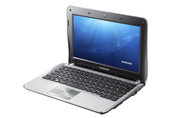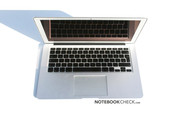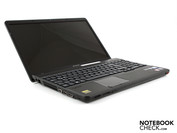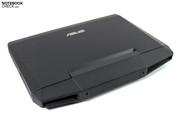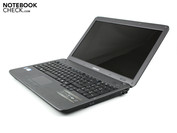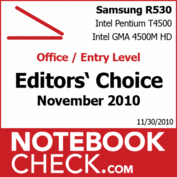Notebookcheck's Best of November 2010
Each month countless notebooks are subjected to our rigorous tests. So that you don't lose sight of the big picture, we present to you here the most exciting devices of the previous month once more.
Note: The following breakdown is based on Ratings assigned during the month of November. Due to an update in our rating algorithm since then, some of the ratings here may differ from those in the updated reviews. Info about the new rating system.
Netbooks
Contenders:
Asus Eee PC 1215T Netbook
Samsung NF310 Netbook
Asus Eee PC 1015PN Netbook
Acer Aspire One D255 Netbook (N550)
Asus Lamborghini VX6 Netbook
In the "featherweight" class—that is, Netbooks—we had five devices to begin with. Since three of these received the top ranking of "Very Good," naming one the "Best of the Month" is particularly difficult.
The Samsung NF310 is a noteworthy contender that in addition to its excellent performance in our review also stands out on account of its unusual "Shark Design" and distances itself a good deal from the competition. The Asus Lamborghini VX6 Netbook scores equally high in the ratings, setting itself apart through a good mix of style and performance. With the combination of an Intel Atom D525 and Nvidia Ion 2 graphics card, the 12" netbook breaks through to subnotebook-level in terms of performance.
Finally, the Asus Eee PC 1015PN is ahead by a nose. The powerful, 10" dwarf promises solid office and multitasking performance thanks to its Intel Atom N550 dual-core processor and Nvidia ION 2 graphics card. There is a catch, though: when the netbook switches to the on-board GMA 3150 graphics card via Nvidia Optimus, the display brightness drops significantly, rendering outdoor use difficult. This problem can, however, be solved by way of a firmware update according to some users, which can nonetheless be difficult for those of us who aren't computer experts. This aspect disqualifies the otherwise top contender in the race for the "Editor's Choice" Award.
Netbook of the Month for November 2010: Samsung NF310
Even if the Eee 1015PN's blunder helped a bit here, there are nevertheless strong arguments that justify the Samsung NF310 Netbook receiving this award.
The 10-inch Samsung benefits from the Intel Atom N550 dual-core CPU with a decent office performance and good battery life of 6 to 8 hours depending on use. On top of that, the high screen brightness of the matte display allows screen contents to remain visible even in direct sunlight. The coup de grâce is the high-resolution (1366x768) HD display, which makes it easy to see and work with multiple applications on screen at once.
Shortcut:
What We Like
Bright, matte, high-resolution display—the way a 10" screen should be.
What We'd Like to See
A Nvidia ION 2 graphics card would have made for the perfect netbook.
What Surprises Us
Good battery life that is comparable to one with a single-core Atom processor.
The Competition
Dual-core alternatives: Asus Eee PC 1015PEM: matte display; Asus Lamborghini VX6: Nvidia ION 2 & Atom D525; Asus Eee PC 1015PN: inexpensive ION 2; Acer Aspire One D255: long battery life.
Subnotebooks
Contenders:
Lenovo ThinkPad Edge 11 Notebook (Intel)
Lenovo Edge 11: Athlon Neo II K325
Apple MacBook Air 13 Zoll 2010
Apple MacBook Air 11 Zoll 2010
In the "subnotebook" class, we had a clash of two completely different worlds several times. In one case, the Intel i3 380UM and AMD Athlon Neo II K325 locked horns over the Lenovo Thinkpad Edge 11, where the AMD model performed quite well and is still less expensive than the structurally identical Intel CPU.
Besides that, Apple impressed us yet again with its two noteworthy creations. The MacBook Air 11 and 13 blur the line between netbooks and subnotebooks with their excellent rankings. After all, it wouldn't be Apple, if they didn't take the road less traveled. The Apple folks out in California have fit their subnotebooks with powerful, however technically outdated Core 2 Duo processors in combination with a powerful graphics card (Nvidia 320M). The outcome is clear: the performance data of other netbooks are crushed. What's more, current subnotebooks with low-voltage configurations are put to shame by the MacBooks' powerful graphics performance.
Subnotebook of the Month for November 2010: Apple MacBook Air 13" 2010
As exciting as the contest with both Thinkpad Edge 11 models might have been, the two compact silver powerhouses from Cupertino stole the show. With their unprecedented flat design pared with good performance and nevertheless long battery life, Apple once again accomplishes the apparently impossible. The build of the one-piece aluminum case—which is currently identified as top-of-the-line for notebooks—is just about standard for aluminum MacBooks.
The choice of the 13-inch model is justified by its greater comfort of use resulting from its larger size as compared to the 11-inch model—while retaining its mobility. At a weight of 1.3 Kg and a battery life of 7 hours or more, the MacBook Air 13 is competing at netbook scale and at the same time destroying the scores of once-proud top contenders in this very category with its powerful performance.
Shortcut:
What We Like
How close the 13" MacBook Air comes to the performance level of a full-sized notebook and how it still remains very mobile.
What We'd Like to See
A matte display and greater accessibility to hardware for upgrades.
What Surprises Us
The amazing sturdiness of the aluminum case despite how thin it is.
The Competition
There is much more competition for the 13" model, of course, than for the 11" model. Particularly, the Sony Vaio Z12 with a powerful processor and graphics card. But, the Lenovo X201s and the Toshiba R700 are also worth noting.
Multimedia Notebooks
Contenders:
Dell XPS 15 FHD
HP Pavilion dv6-3051sg
Asus N73JQ
Sony Vaio VPC-F13Z1E/B
Asus N82JQ
Schenker XMG A500
Sony Vaio VPC-EB3Z1E/B
Multimedia notebooks have quite an extensive set of tasks to accomplish. On the one hand, they need to have comprehensive mutlimedia capabilities (ports, display, performance, types of media) while at the same time retaining a decent level of mobility. Few notebooks can manage this difficult balancing act, which evident from the ratings for November 2010. None of the models reviewed in this class achieved the top rating of "Very Good". Nevertheless, several particularly exciting notebooks did end up struggling through our obstacle course of tests. We start off with the new Dell XPS 15, which measures up to other notebooks of the much-talked-about XPS series. Sony threw in its chips on two formidable notebooks, the Vaio F13Z and the Vaio EB3Z. The Asus N82JQ represented a rarer, more compact 14-inch design furnished with a powerful GT335M graphics card and an Intel quad-core CPU.
Multimedia Notebook of the Month for November 2010: Sony Vaio VPC-EB3Z1E/BQ
Although the much-discussed Sony F13Z's matte, full-HD display and remarkably broad color space combined with the powerful GT425M GPU and i7 740QM CPU looks very nice on paper, the Sony EB3 wins out in the overall ratings thanks to its Intel i5 dual-core CPU, HD 5650 GPU and sRGB full-HD display. The F13Z model lost some points on account of its battery life, system noise—particularly the frequently observed whistling noise that F13Z models tend to make—allowing the award to go to the Sony Vaio EB3Z.
This notebook presents quite an attractive deal in terms of its price-to-performance ratio and is, as a matter of fact, listed below the 1,000 Euro mark in some stores. Considering the hardware on board, the high-quality display, and the comfortable keyboard, those looking for a well-rounded multimedia notebook will really get their money's worth.
Shortcut:
What We Like
Finally, a display worth recommending in a consumer notebook. We rarely get to see such a broad range of viewing angles and such a good contrast ratio.
What We'd Like to See
A touchpad that responds better and has scrollbars like any cheap notebook today, why not this Vaio?
What Surprises Us
The gradual change in exhaust fan speed makes it almost unnoticeable (under heavy use).
The Competition
Those steering clear of the ATI HD 5650 should look to the Aspire 5820TG, TravelMate 5740G, L650D-10H from Toshiba, and the Sony Vaio VPC-EB1S1E/BJ. Full-HD options include the Vaio VPC-F12Z and the new version of the F13; ASUS N53JQ-SZ137V: GeForce GT425M; MSI GT660R-i7488BLW7P: heavy gaming notebook; Sony Vaio VPC-Z12C7E/B: powerful dwarf;
Gaming Notebooks
Contenders:
Asus G53JW Notebook FullHD
Schenker XMG U700 ULTRA
Packard Bell EasyNote LX86
Deviltech HellMachine HD 5870 X2
MSI GX660R Gaming
In the previous month we reviewed a considerable number of powerful gaming notebooks, so much so that we've decided to present an award for this class of notebooks. Several laptops battled it out for the award including the Asus G53JW notebook with a full-HD display, the XMG U700 from Schenker Notebooks, and the Deviltech Hellmachine fitted with two GeForce GTX 460M dedicated graphics cards on top of ATI's currently most powerful combination of two HD5870 on-board GPUs.
Compared to these formidable models, the Packard Bell LX 86 can hardly compete with its on-board ATI HD 5850, let alone the MSI GX660 which might have a more powerful HD 5870 but pays for it with poor sound and display quality.
Gaming Notebook of the Month for November 2010: Asus G53JW Full HD Notebook
Even though the Asus G53JW didn't score enough points for an overall rating of "Very Good", it still won the "Editors' Choice" award for November 2010 fair and square. The stealthy case design really fits the profile of a gaming notebook. Asus shied away from a scratch-prone glossy design and colorful blinking lights, instead focusing on sturdiness. In addition to its solid 3D performance thanks to the Nvidia GeForce GTX 460M graphics card and the Intel i7 740QM quad-core processor, the notebook is quite appealing due to its outstanding cooling system, which keeps the fan spinning quietly and at the same time keeping the case temperature in check. During typical office use, the notebook is whisper-soft. Why the overall rating didn't amount to a "Very Good" is largely to blame on the display, which offers quite a high resolution but skimps too much on the contrast ratio.
Shortcut:
What We Like
Full HD instead of 3D. The advantages of a full-HD display outweigh those of a low-resolution 3D display.
What We'd Like to See
More thorough research about the specifications on part of some stores which wrongly identified the ST098V as having a 1366x768 HD display.
What Surprises Us
The blunder about the maximum screen contrast ratio should really not have been made.
The Competition
The G53JW with a 3D display with the same case structure; or the larger Asus G73JW with otherwise identical features. Toshiba's Qosmio X500 is also fitted with a GTX 460M graphic card, however housed within a larger 18" case. A compact alternative would be the Schenker Notebook XMG P500 or the Medion X8611/12.
Office / Entry Level
Contenders:
Samsung R530
MSI CR630
HP Compaq Presario CQ62
Acer Aspire 5552G
Fujitsu Lifebook AH530
When considering office/entry-level notebooks, one detail stands out above the rest: the price. A lower price, however, comes at the expense of available features or performance. Nevertheless, in light of how little is demanded from notebooks of this class, skillfully weighing individual features against savings can result in a high score.
Five devices were considered in the contest for the "Editors' Choice" award in the month of November. First up, the Samsung R530 comes at a bit over 400 Euro equipped with a dual-core CPU and classic office features like a sturdy case. The MSI CR630—fitted with an AMD CPU—costs less than 400 Euro. The HP CQ62, also with AMD hardware comes, however, at a higher price of app. 500 Euro. The Acer Aspire 5552G, also fitted with AMD components and an HD5470 graphics card, arguably branches out to the multimedia notebook class. At a price approaching 600 Euro, this notebook is in a category of its own. Finally, Fujitsu tries its hand at the office/entry-level class with the Lifebook AH530 which comes with an Intel Core i3 CPU and ATI 550v graphics card at a similar price.
Office/Entry-Level Notebook of the Month for November 2010: Samsung R530
As previously mentioned, it's not purely performance that counts in this class of notebooks, rather a well-rounded package and a reasonable price is the key. With that in mind, only one candidate can logically be the winner here: the Samsung R530.
Starting at 430 Euro, you get an entry-level notebook perfectly suited for office work with a good keyboard, bright screen and particularly low level of system noise—which won it a lot of points. The case is remarkably sturdy for this price range and the battery life of 3-4 hours is also quite nice.
Shortcut:
What we Like
It has few features but is still a good notebook. The excellent keyboard, the durable case and the decent processing power at an attractive price.
What We'd Like to See
An anti-glare display would have turned the R530 Nolan into a perfect office notebook.
What Surprises Us
The experimental yet appropriate case surface. This notebook does just fine without a glossy finish.
The Competition
Simple office laptops without the bells and whistles. Fujitsu LifeBook A530: Core i3; Lenovo IdeaPad G560: also with an i3 CPU; HP 625: anti-glare; HP 620: dual-core; HP Compaq Presario CQ62: dual-core; MSI CR630: single-core AMD; Lenovo G550: T4500-configuration.
Miscellaneous
Toshiba AC100 MID/Netbook (Android)
Samsung Galaxy Tab 7-Zoll Tablet/MID
HP Elitebook 8540w (ATI M5800) Workstation
Three devices are left over that didn't fit into any other notebook class. The Toshiba AC100, a 10" notebook running on Android OS with the Nvidia Tegra processor, is basically a smartphone dressed as a notebook. The device was however not up to standards in our review—working with Android OS via mouse and keyboard was awkward and painstaking.
We also reviewed the Samsung Galaxy Tab, supposedly the biggest threat to the iPad, although in a more compact pocket-sized format.
Finally, the HP 8540w—an honest-to-goodness Workstation for professionals—was also probed and analyzed. With an overall rating of "Very Good", this notebook has found its place on the market.
Due to the lack of comparable devices, none of these was considered for an award for the month of November but might be taken into consideration this month.






